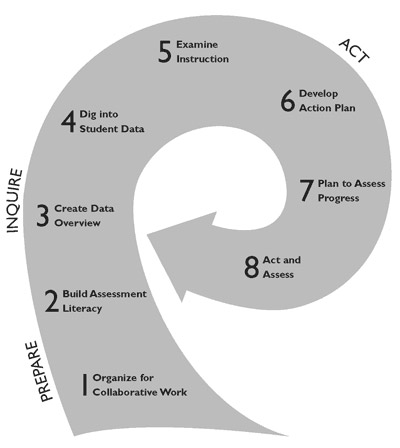

The Data Wise Project at the Harvard Graduate School of Education is designed to help schools turn student assessment data into a tool to improve instruction and transform the act of data analysis into a process that elevates the organization, function, and climate of schools. A step-by-step guide to this process, for schools and school districts, is described in the authors' recent book, Data Wise, published by the Harvard Education Press.
The group of Harvard faculty, graduate students, and school leaders from the Boston Public Schools who designed Data Wise envisioned the process of learning to use data constructively as one that could also serve as a toe-hold for the overwhelming and amorphous task of instructional improvement. In a series of seminars led by Harvard Graduate School of Education faculty Richard Murnane, Kathryn Boudett, and Elizabeth City, the group developed an eight-step Data Wise cycle as a means to help school leaders organize the work of school improvement around a process that has specific, manageable steps.
"The Data Wise process itself can offer a way of getting traction in the often overwhelming task of becoming a learning organization," says Boudett. "You can't just tell a group of teachers to collaborate; you need to collaborate on a shared task."

If faithfully implemented, the Data Wise process can serve as a catalyst for the very organizational conditions that enable schools to successfully respond to external demands for improvement. In his work on accountability policy, HGSE Professor Richard Elmore has found this development of internal accountability to be a critical component of improving schools. As he explains; "probably the most robust finding to date from research on accountability policies is that the strongest initial predictors of the impact of policy on student performance are the attributes of schools rather than the attributes of the policies themselves." Before schools can respond to external pressure for increased academic performance, they must transform themselves from atomized, incoherent organizations to ones in which faculty share an explicit set of norms and expectations about what good instructional practice looks like.
The Data Wise improvement cycle, which is replete with protocols and strategies for structuring the tough conversations and overcoming resistance, should enable schools to do just that. "It is true that we recommend school leaders begin by looking at results from standardized tests" says Murnane. "But the heart of the work is in finding ways to engage school faculties in tough conversations about how their teaching impacts student learning."
When school leaders and faculty embark on the improvement cycle, progress from one step to the next is designed to create its own demand for the qualities associated with improving schools. The transition from step four, "Dig into Student Data," to step five, "Examine Instruction" is a perfect example. In step four, faculty delve into various forms of student assessment data to identify a learner-centered problem, or problem of understanding common to many students and evident from performance on standardized assessments. To move on to step five, teachers must investigate the manner in which they currently teach to this skill and recast the learner-centered problem as a problem of practice. A faithful implementation of the process laid out in the book would lead to the adoption of numerous practices associated with high-performing schools. These include:
• Collective responsibility for learning
In order to reframe the learner-centered problem as a problem of instruction, teachers must reflect on the link between instructional practice and student learning, rather than attribute learning difficulties to weak students or deficient home lives.
• A shared understanding of effective practice
Before they are able to articulate a problem of practice, teachers must come to an understanding of what effective instruction for the identified learning problem would look like.
• Classrooms open to teacher colleagues for observation and analysis
In order to articulate a problem of practice teachers must make use of instructional data which they collect through observations of their colleagues' classrooms and contrast current practice with their shared expectation of effective instruction for the identified learning problem.
By charging teachers with developing solutions of practice to the problems they have identified from their own data, Data Wise has the potential to combat another challenge to improving schools. Many educators do not believe that they have the capacity to influence student learning in the ways that external accountability systems suggest they should. "If you really follow the Data Wise model," City says, "the principal begins to allow teachers to take leadership roles in helping to frame what the instructional challenges are and how the school is going to address them. Teachers feel more control over their work."
Research has shown a connection between teachers' control over their work and perceptions of their effectiveness in teaching — an attitude powerfully linked to their willingness to take responsibility for student learning. "Teachers learn to draw connections between their instructional practice and student learning through the deliberate analysis of data," says Richard Elmore, "and this sense of efficacy in teaching is central to internal accountability at the school level."
Continuing research by the Data Wise team will now focus on how to assist school leaders to leverage the process for broader, whole school improvement. Early lessons from the field have made clear three conditions for success that school leaders considering the initiative should keep in mind. The first is the need to distribute and cultivate leadership among faculty with relevant expertise: no principal will be able to meaningfully implement this work alone. The second is the critical nature of scheduling: ongoing, collaborative time for teachers to talk about data and instruction is vital to the program's success. Finally, successful schools recognize that the Data Wise process is designed to circle back on itself, and that those changes that do not take root the first time around are not cause for abandoning the work: the Data Wise process is a recursive one, in which data collection and analysis become part of the school culture in the ongoing pursuit of improved student achievement.